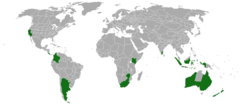Acacia baileyana
Read about Acacia baileyana in the Standard Cyclopedia of Horticulture
|
|---|
|
Acacia baileyana, F. v. M. An attractive shrub or small tree, with gray foliage arranged spirally around the branchlets and nearly concealing them: lvs. compound, 1-2 in. long, with gland at base of each pair of pinna; pinnae 2-3 pairs (occasionally 4); 1 in. long; lfts. about 20 pairs, 1/4in. long, nearly 1/16in. wide: racemes longer than lvs., 2-3 1/2in. long; fls. 15 in a head, on peduncles 1/8-1/4in. long: pod l 1/2-4 in. long, 1/2in. wide, with nerve-like margins, occasionally constricted between seeds; seeds transverse, 1/4in. long, with club- shaped funicle one-half its length; ripe July, Aug. Fls. Jan., Feb. F. v. M. Icon. 12:5. G.C. III. 15:37.—A much-prized ornamental and sometimes used as a street tree.
|
| Sunset Zones: | 7-9, 13-24, 26-28 |
|---|
The Cootamundra Wattle is a shrub or tree in the Family Fabaceae. The Latin name of the species honors the botanist Frederick Manson Bailey. It is but one of nearly 1000 species of Acacia found in Australia. The Cootamundra Wattle is indigenous to a small area in southern New South Wales but has been widely planted in other Australian states. In many areas of Victoria Cootamundra Wattle has become naturalised and is regarded as weed, outcompeting indigenous Victorian species.
Almost all wattles have cream to golden flowers. The small flowers are arranged in spherical to cylindrical inflorescences, with only the stamens prominent. Wattles have been extensively introduced into New Zealand and are regarded by many New Zealanders as one of the most typical features of their home landscape.
Cultivation
This plant is adaptable and easy to grow. Unfortunately it has an ability to naturalize (i.e. escape) into surrounding bushland. Also, it hybridizes with some other wattles, notably the rare and endangered Sydney Basin species Acacia pubescens.
A prostrate weeping form is in cultivation. The fine foliage of the original Cootamundra wattle is grey-green, but a blue-purple foliaged form, known as 'Purpurea' is very popular.
Propagation
Pests and diseases
Uses
A. baileyana is used in Europe in the cut flower industry. It is also used as food for bees in the production of honey.[1]
Less than 0.02% alkaloids were found in a chemical analysis of Acacia baileyana.[2]
History
Taxonomy
| {{{name}}} | ||||||||||||||||
|---|---|---|---|---|---|---|---|---|---|---|---|---|---|---|---|---|
| Plant Info | ||||||||||||||||
|
| ||||||||||||||||
| Scientific classification | ||||||||||||||||
| ||||||||||||||||
| Binomial name | ||||||||||||||||
| Acacia baileyana F.Muell. | ||||||||||||||||
|
| ||||||||||||||||
 Range of Acacia baileyana | ||||||||||||||||
| Synonyms | ||||||||||||||||
| *Acacia baileyana F.Muell. var. aurea Pescott |
Gallery
An wattle in Australia.
A. baileyana prostrate form in cultivation, Illawarra Grevillea Park, Bulli, NSW



